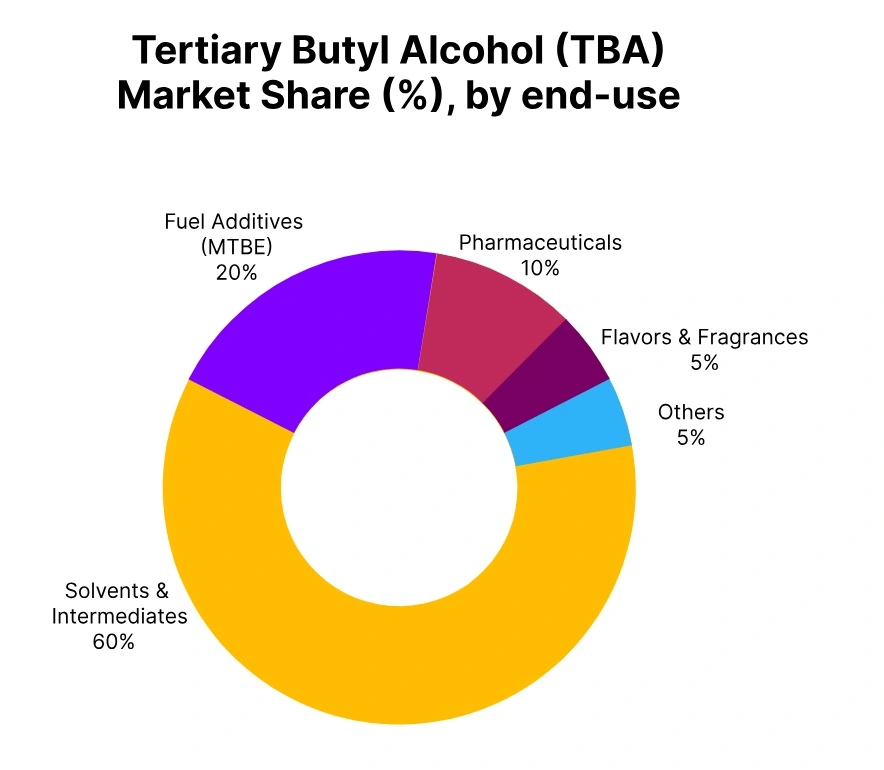Price-Watch’s most active coverage of Tertiary Butyl Alcohol price assessment:
- (99.5% min) Industrial Grade FOB Shanghai, China
- (99.5% min) Industrial Grade FOB Tokyo, Japan
- (99.5% min) Industrial Grade CIF Haiphong (China), Vietnam
- (99.5% min) Industrial Grade CIF JNPT (China), India
Tertiary Butyl Alcohol (TBA) Price Trend Q3 2025
In Q3 2025, Tertiary Butyl Alcohol (TBA) prices declined across major markets, including China 4.99%, Vietnam 4.87%, India 3.02%, and Japan 0.69%. Weak domestic demand, particularly from the automotive and coatings sectors, along with oversupply conditions, contributed to the price drops. Stable production and feedstock costs provide limited support.
Vietnam and India faced additional pressure from high logistics costs. The outlook for the upcoming quarter remains cautious, with the potential for further price declines unless demand from key sectors, including automotive and coating, improves.
China
Tertiary Butyl Alcohol Export prices FOB Shanghai, China, Grade- (99.5% min) Industrial Grade.
According to PriceWatch, in Q3 2025, Tertiary butyl alcohol (TBA) prices in China declined by 4.99% compared to Q2. The Tertiary butyl alcohol (TBA) price trend in China has been influenced by weak domestic demand, particularly from the automotive and coatings sectors, which led to reduced consumption. Despite stable production levels, oversupply conditions persisted, exerting downward pressure on prices.
Feedstock costs remained relatively stable, providing minimal support to the market. Tertiary butyl alcohol (TBA) prices in September 2025 have been lower than in Q2, continuing the downward trend. The outlook for the upcoming quarter remains cautious, with potential for further price declines if demand does not improve.
Japan
Tertiary butyl alcohol (TBA) Export prices FOB Tokyo, Japan, Grade- (99.5% min) Industrial Grade.
Tertiary Butyl Alcohol (TBA) prices in Japan saw a small decline of 0.69% in Q3 2025 from Q2. The Japanese Tertiary butyl alcohol (TBA) price trend mirrored spot market conditions and has been related to weaker demand in the automotive and construction key sectors as a result of weaker consumption. A steady demand of Tertiary butyl alcohol coming from medical and cosmetic domains helped maintain prices.
Feedstocks remained predominantly stable and provided only minimal upward support for the Japanese market. Tertiary butyl alcohol prices have been slightly lower for September 2025 compared to Q2 2025. Moving into the next quarter, all indications are stable, as they depend on momentum in demand and should have some level of changes this fall.
Vietnam
Tertiary butyl alcohol (TBA) import prices CIF Haiphong, Vietnam, Grade- (99.5% min) Industrial Grade.
In Q3 2025, Tertiary Butyl Alcohol prices in Vietnam fell by 4.87%, following a 4.36% decline in Q2. The downward price trend in Tertiary butyl alcohol (TBA) prices in Vietnam has been related to weak domestic consumption, particularly from the automotive and chemical industries, which have both seen slowdowns in production. Imports from China have been stable, but demand from domestic manufacturers has been lower than anticipated.
Regional supply chain challenges, included transportation delays, higher logistics costs, and general deterioration of the economic environment since the last year, constrained the Tertiary butyl alcohol (TBA) price this quarter. Tertiary butyl alcohol prices in Vietnam in September 2025 continued the downward trajectory from the previous quarter. The next quarter price stabilization will be contingent on the rebound in industrial activities and demand in the principal markets.
India
Tertiary Butyl Alcohol import prices CIF JNPT, India, Grade- (99.5% min) Industrial Grade.
According to PriceWatch, in Q3 2025, Tertiary Butyl Alcohol (TBA) prices in India experienced a 3.02% decline after a 4.84% decrease in Q2. The downward price trend in Tertiary butyl alcohol (TBA) prices in India has been a result of reduced demand in certain sectors such as automotive and coatings where production and consumption have been sluggish.
Though imports from China have been stable, low domestic demand along with high inventory levels put additional pressure on Tertiary butyl alcohol (TBA) prices.
Also, the depreciation of the Indian Rupee resulted in higher import costs further limiting any potential for recovery in prices. Tertiary butyl alcohol (TBA) prices in India remained lower in September 2025 as compared to August 2025, and the Tertiary butyl alcohol (TBA) market in India is likely to remain under pressure unless demand from key sectors improves in the forthcoming months.




